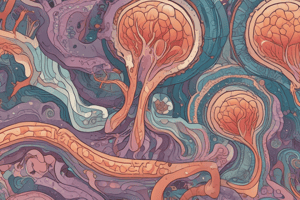Podcast
Questions and Answers
What does the term 'growth development' likely refer to?
What does the term 'growth development' likely refer to?
- Expansion and improvement in an organization (correct)
- Increasing relationships
- Maintaining static processes
- Limiting factors for success
Truncation at the line is a process that limits the potential output.
Truncation at the line is a process that limits the potential output.
True (A)
What is the primary focus of the content related to growth development?
What is the primary focus of the content related to growth development?
Expansion and improvement within an organization
The process of _______ is responsible for shaping how outcomes project in a system.
The process of _______ is responsible for shaping how outcomes project in a system.
Match the following concepts with their definitions:
Match the following concepts with their definitions:
Flashcards
Cellular growth
Cellular growth
Development process affecting cell size and shape.
Signaling pathway
Signaling pathway
A series of molecular events triggering a cellular response.
Developmental process
Developmental process
Stages in the growth and development of an organism.
Truncation at line
Truncation at line
Signup and view all the flashcards
Cellular development
Cellular development
Signup and view all the flashcards
Study Notes
Organogenesis - Part 1
- Imaginal discs originate from embryonic ectoderm and remain until metamorphosis
- Discs develop according to their segmental location
- Initially, discs are a cluster of 20-40 cells, growing to 1000-fold during larval development
- Disc size can be restored if cells are removed or destroyed
- Wing and leg patterning strategies are similar to vertebrate limb patterning, suggesting parallel evolution
Adult Wing Emergence
- Adult wings emerge during metamorphosis after folding and invagination of imaginal discs
- Initially future wing surfaces (dorsal and ventral) are in the same plane within the imaginal disc (ID)
- At metamorphosis, the ID folds, turning inside out, extending to the dorsal and ventral surfaces
- The ID is divided into A and P (anterior and posterior) compartments
- The wing joins the thoracic wall (notum) via a hinge
- Initially the ID contains cells that specify both notum and hinge, but not the wing itself; the wing primordium emerges in the first instar
- Vestigial expression is promoted by Notch and Wingless signalling
Dpp Patterns in Drosophila Wing Disc
- Engrailed and Hedgehog signalling are located in the posterior region of the imaginal disc (ID)
- Hedgehog (Hh) can act as a morphogen
- The transcriptional effector of Hh (Ci) is expressed only in anterior cells, meaning anterior cells respond to Hh
- Decapentaplegic (Dpp) is a BMP family member, expressed in a narrow stripe at the anterior side of the compartment boundary (organising centre)
- Dpp gradient represses Brinker, while activating Spalt (Sal) and Optomotorblind (Omb)
- Brinker represses sal and omb
A Signaling Centre at the Boundary Between A/P Compartments
- Dpp acts as a morphogen in the patterning of the wing, varying by low or high levels
- Veins form as a result of A/P patterning activity of both Hh and Dpp
- A mirror-symmetric wing pattern is produced when Hh is expressed ectopically in the anterior compartment
A Signaling Centre at the Boundary Between D/V Compartments
- The wing disc is subdivided into D (dorsal) and V (ventral) compartments
- Apterous and Notch ligand (Serrate & Delta) expression lead to wingless expression at the center of the boundary
- Increased expression of vestigial, a critical regulator, emerges from this combined action
Vestigial Integrates Different Signals
- Vestigial is a transcriptional co-activator necessary and sufficient for wing development
- Vestigial expression in small groups of 30 cells located in the middle of the wing disc of first instar larvae is controlled by the 'boundary enhancer'
- Notch andWg promote vestigial expression
- Wg and Dpp promote vestigial expression later through a 'quadrant enhancer', promoting wing cell proliferation and outgrowth
Drosophila Leg Disc Extension
- Insect legs are jointed tubes of epidermis
- The epidermis secretes a hard outer cuticle (exoskeleton)
- Leg discs comprise approximately 30 cells initially, increasing to over 10,000
Leg Disc Patterning
- Leg disc patterning follows a similar process to wing disc patterning, involving expression of Engrailed, Hedgehog and Dpp
- Distal tip of the leg (proximo-distal axis) patterning is marked by expression of Distal-less
- Dpp and Wg downregulate homothorax (hth) and induce dachshund (dac)
Vertebrate Limb Bud Development
- Limb buds begin as small protrusions on the body wall, containing mesenchymal cells from lateral plate mesoderm and cells from the somites destined for muscle
- An outer epithelial layer (apical ectodermal ridge, AER) forms along the boundary of the dorsal and ventral ectoderm
- Undifferentiated mesenchymal cells beneath the AER differentiate to produce varied limb components, beginning proximally (closer to the body) and progressing distally (the limbs tips)
Genes in Lateral Plate Mesoderm
- Hox genes in lateral plate mesoderm play key roles in limb development and positioning, triggering Tbx5, Tbx4, and Pitx1 expression in specified regions (hindlimb/leg vs. forelimb/wing)
- Fgf10 signalling initiates Fgf8 expression, establishing a positive feedback loop
- FGFs help in initiating and maintaining the mesodermal polarizing region aiding in anteroposterior patterning of limb buds.
- Once forming, limb buds become relatively autonomous units in development.
Apical Ectodermal Ridge
- AER is critical for the limb's proximo-distal outgrowth
- Removal of the AER leads to truncation of specific structures along this axis.
- Ions and small molecules flow directly between cells within the AER due to gap junctions, critical to limb development
- FGFs can promote nearly normal development of the limb in an AER removal scenario.
Studying That Suits You
Use AI to generate personalized quizzes and flashcards to suit your learning preferences.
Related Documents
Description
This quiz explores the process of organogenesis, focusing on the development of imaginal discs from embryonic ectoderm and their transformation during metamorphosis. It highlights the mechanism of adult wing emergence, discussing the role of dorsal and ventral surfaces, compartmentalization, and evolutionary parallels with vertebrate limb patterning.




